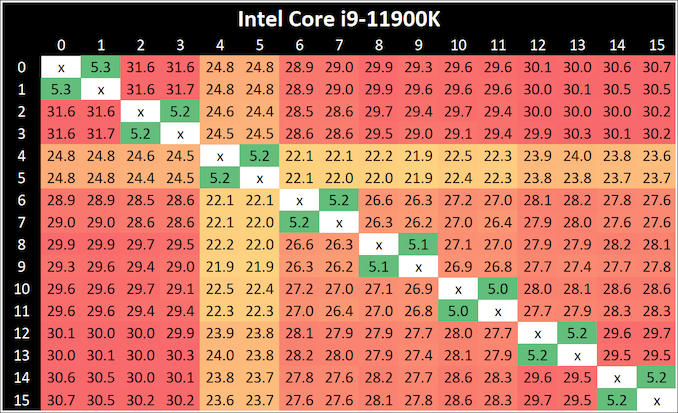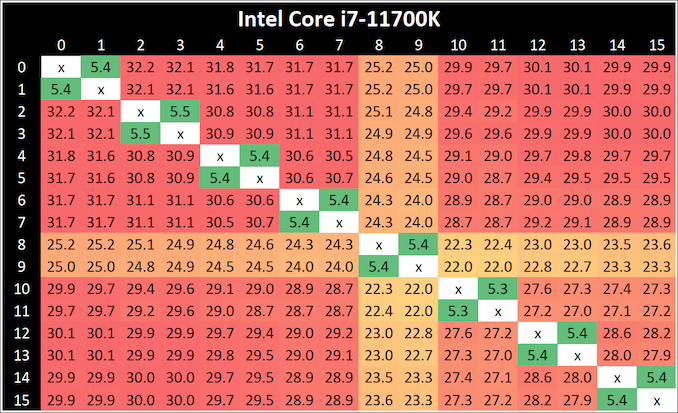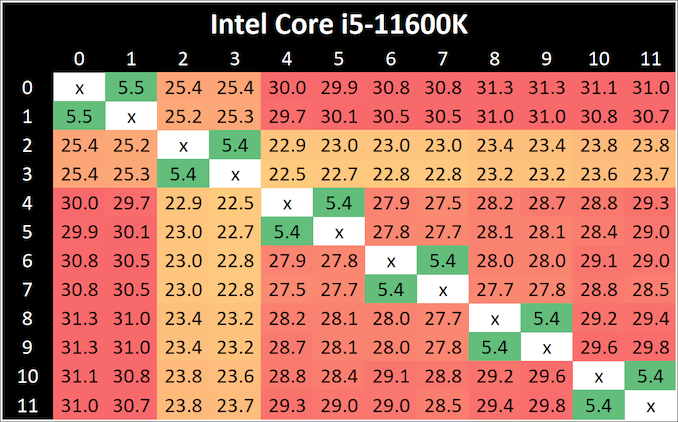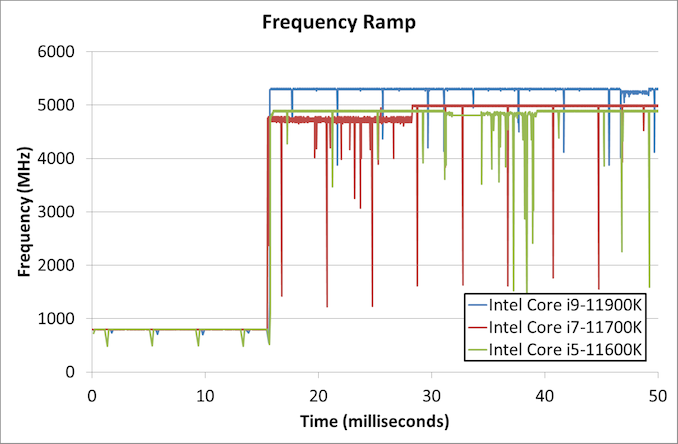Intel Rocket Lake (14nm) Review: Core i9-11900K, Core i7-11700K, and Core i5-11600K
by Dr. Ian Cutress on March 30, 2021 10:03 AM EST- Posted in
- CPUs
- Intel
- LGA1200
- 11th Gen
- Rocket Lake
- Z590
- B560
- Core i9-11900K
CPU Tests: Microbenchmarks
Core-to-Core Latency
As the core count of modern CPUs is growing, we are reaching a time when the time to access each core from a different core is no longer a constant. Even before the advent of heterogeneous SoC designs, processors built on large rings or meshes can have different latencies to access the nearest core compared to the furthest core. This rings true especially in multi-socket server environments.
But modern CPUs, even desktop and consumer CPUs, can have variable access latency to get to another core. For example, in the first generation Threadripper CPUs, we had four chips on the package, each with 8 threads, and each with a different core-to-core latency depending on if it was on-die or off-die. This gets more complex with products like Lakefield, which has two different communication buses depending on which core is talking to which.
If you are a regular reader of AnandTech’s CPU reviews, you will recognize our Core-to-Core latency test. It’s a great way to show exactly how groups of cores are laid out on the silicon. This is a custom in-house test built by Andrei, and we know there are competing tests out there, but we feel ours is the most accurate to how quick an access between two cores can happen.
All three CPUs exhibit the same behaviour - one core seems to be given high priority, while the rest are not.
Frequency Ramping
Both AMD and Intel over the past few years have introduced features to their processors that speed up the time from when a CPU moves from idle into a high powered state. The effect of this means that users can get peak performance quicker, but the biggest knock-on effect for this is with battery life in mobile devices, especially if a system can turbo up quick and turbo down quick, ensuring that it stays in the lowest and most efficient power state for as long as possible.
Intel’s technology is called SpeedShift, although SpeedShift was not enabled until Skylake.
One of the issues though with this technology is that sometimes the adjustments in frequency can be so fast, software cannot detect them. If the frequency is changing on the order of microseconds, but your software is only probing frequency in milliseconds (or seconds), then quick changes will be missed. Not only that, as an observer probing the frequency, you could be affecting the actual turbo performance. When the CPU is changing frequency, it essentially has to pause all compute while it aligns the frequency rate of the whole core.
We wrote an extensive review analysis piece on this, called ‘Reaching for Turbo: Aligning Perception with AMD’s Frequency Metrics’, due to an issue where users were not observing the peak turbo speeds for AMD’s processors.
We got around the issue by making the frequency probing the workload causing the turbo. The software is able to detect frequency adjustments on a microsecond scale, so we can see how well a system can get to those boost frequencies. Our Frequency Ramp tool has already been in use in a number of reviews.
From an idle frequency of 800 MHz, It takes ~16 ms for Intel to boost to the top frequency for both the i9 and the i5. The i7 was most of the way there, but took an addition 10 ms or so.














279 Comments
View All Comments
mitox0815 - Tuesday, April 13, 2021 - link
Hard to see that as a selling point...niche functionality doesn't really shine when paired with noticeable performance and VAST efficiency disadvantagesHifihedgehog - Tuesday, March 30, 2021 - link
Yawn... wake me up in 9 months when Alder Lake is out. Honestly, what a snoozefest.TristanSDX - Tuesday, March 30, 2021 - link
they should backport Golden Cove than Sunny Cove. Maybe with 12 gen (Golden Cove core) they release i9, i7 and i5 on 10 nm, while i3, Pentium and Celeron on 14 nmPaulHoule - Tuesday, March 30, 2021 - link
Intel is making a big branding mistake when they come out with "i9"; they should just admit the state they are in and make it "i1" or "i-2" instead.BushLin - Tuesday, March 30, 2021 - link
They won't fool the geeks but the majority of the market just sees confusing product names on a Dell dropdown option and will pick the bigger number if they can afford it. Sad but true.mitox0815 - Tuesday, April 13, 2021 - link
We proudly introduce the Intel Core iGotNothinBagheera - Tuesday, March 30, 2021 - link
we all knew RKL was gonna be a steaming pile when it was announced, but Intel fanboys kept believing in miracles.moving the goalpost 101:
- "Rocket Lake will trash Zen 3!" (fail)
- "Rocket Lake will be so much cheaper!" (epic fail)
- "Rocket Lake will have stock at least..." (yes because nobody is buying them lol)
schujj07 - Tuesday, March 30, 2021 - link
"The i7 benchmarks are invalid because they are early"Well they were quite indicative of what we are seeing from the 11900k.
arashi - Wednesday, March 31, 2021 - link
Rocket Lake will do 5.6!!!WaltC - Tuesday, March 30, 2021 - link
Intel has become a company run by old men, for old men, and by old men. Just interesting to see that the former CPU Emperor has no clothes...all that time...all that time ahead of AMD and Intel had nothing at all in the oven. Not one bloody thing! Absolutely amazing--points out with drama what's wrong when major hardware markets are dominated by monopolists like Intel.